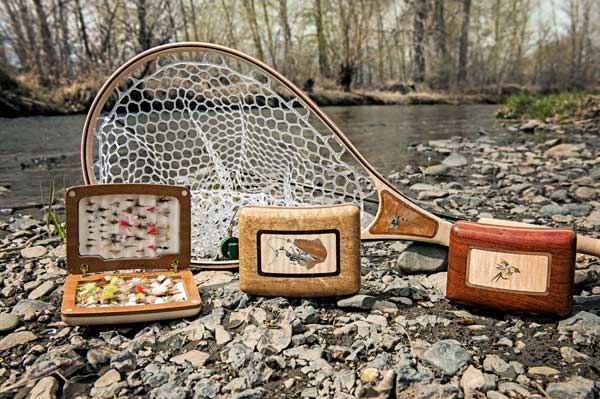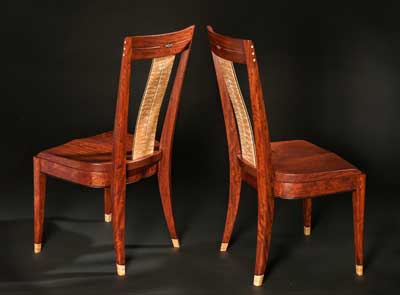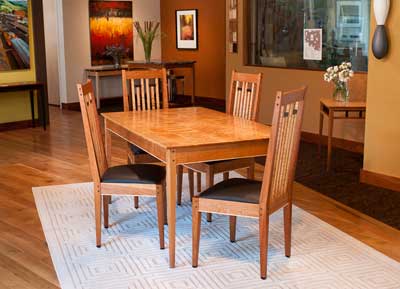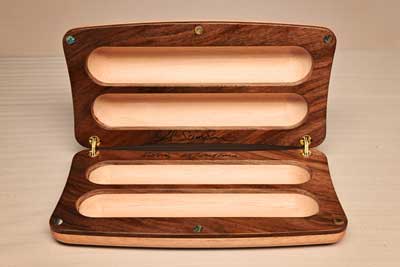
When Al Swanson moved to Montana, in the heart of the fly fishing region, about 15 years ago, his woodworking was noticeably different than others’ in the region. “Everything was very loggy,” he said. “My work stood out. It has kind of a neo-Shaker flair.” That means, he said, his work is very artistic, but very functional. It’s an influence that comes from growing up about 10 miles from Sabbathday Lake in Maine, the last active Shaker community.
In the early days, Al said, he built cabinets and built-ins, but has gotten away from that, focusing more on standalone items like tables, chairs, etc., finished with a proprietary blend of varnish, beeswax and boiled linseed oil, hand-rubbed over the course of two weeks. Right now, Al said, he’s really into dining room chairs, with one current hourglass-shaped design being the result of 15 years’ worth of refinements and sit tests.
Al prefers not to stain his work, and says “I rarely build anything with less than three wood colors to it.. He loves to work with highly figured wood, citing in particular quilted maple, Eastern tiger maple, Pennsylvania cherry, walnut and African bubinga. Al also still has a stash of oaks and pines that were cut from his family farm in New England. “I generally don’t work with oaks and pines, but if I can do with with wood cut with my dad when I was a kid, that makes it special.”
The chairs and tables in his showroom gallery in downtown Helena, Montana, are surrounded by artwork, due to a relationship with artists. Soundproof glass walls enable visitors to look into studio and see him and his employees at work. These amenities, plus the location near hotels and restaurants, are purposeful efforts at good marketing – the lack of which, Al says, is what he thinks causes the failure of many woodworkers’ businesses.
It’s also part of the thought process behind his newest products, for fly fishermen. “This area has a lot of tourists, fly fishermen in particular. You look out the window and see fishermen get out of the hotel shuttle, and we’re missing that customer. They’re not going to buy a $2,000 chair; they can’t fit it in a suitcase. We needed something they could use that day to appeal to the same market, but on a smaller, more affordable scale.”
Last summer, he created a prototype box for fishing flies, “out of beautiful, figured woods, with everything you would use on the river. Very functional, very beautiful.” Not satisfied with merely selling these boxes on the floor of his shop in Helena, Al contacted someone he had met about eight years ago, when “A guy walked in, and he had a broken net that his dad had given to him, and he needed it fixed. That’s not exactly what we do, but I felt sorry for him. The guy was Simon Perkins, a member of the family which owns the Orvis fishing, hunting and sporting goods retailer. “It was a pretty good guy to do a good deed for,” Al said.
Al sent his prototype boxes to Orvis, and waited for a response. When he got one, it was “How many can you make?” “I was like: I have no idea. We’ve made two.”
The usual output of Al’s shop is “a couple of chairs a month, a table here and there …” he said. With the request from Orvis, he added employees, for a current staff of about 5-1/2 people (one is part-time), and “we got busy, and made many hundreds of fly boxes.” Tasks for building the boxes include resawing, glue-up, sanding and finishing, with a CNC router to assist with repetitive operation. The boxes, Al said, “are made with the same exact quality and care as high-end furniture. My signature accompanies every single one,” while he oversees the operation and continues to build chairs and tables.
The fly boxes made the cover of Orvis’s flagship holiday catalog last fall and almost completely sold out before Thanksgiving. “They had us make more, because it was a long ways before Christmas. Before we even had the second batch done, we sold out again,” Al said.
He has now added nets and cigar boxes to the smaller products line. The cigar boxes are built like a fly box, with a two-notch trough of raw, unfinished cedar in the interior. “The cigar never comes in contact with anything but raw cedar; it’s meant to use that day,” Al said.
He’s also continuing to improve the boxes, with such refinements as using rare-earth magnets for a gentle but secure closure, capped with mother-of-pearl or abalone dots to add an aesthetic element that is also functional in preventing rust. A brass post on one corner allows tethering the box to a lanyard, to prevent it floating away – despite many people using the boxes as desktop or mantelpiece display items, “it’s meant to be used,” Al said. “It you drop it, it’s going to float.”
The newest boxes in the line are also named after iconic Montana rivers, and each have a fly inlaid on the front, with the hook created out of polished metal and abalone shell adding shimmer on the wings. The boxes are finished with a sprayed-on two-part conversion varnish to add shimmer and water protection, and come in a presentation box that includes facts about the river and the type of fly – as well as fresh Spanish cedar shavings off the bench in Al’s workshop.
“Demand is dramatically increasing products, and we’re hardly even trying,” Al said. He expects to potentially be up to a staff of 10 by the end of the summer. He feels the small pieces add value to his larger pieces, and “It’s like a micro manufacturing firm in the middle of the city,” he said.












